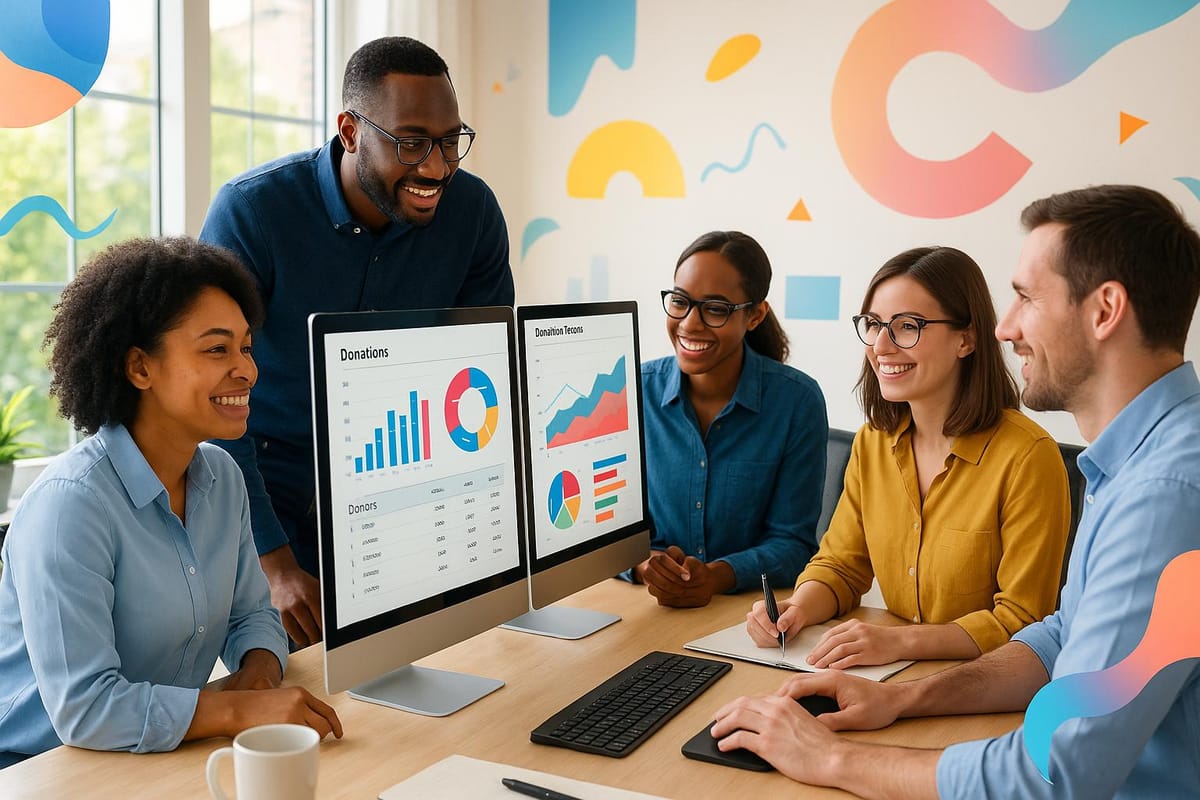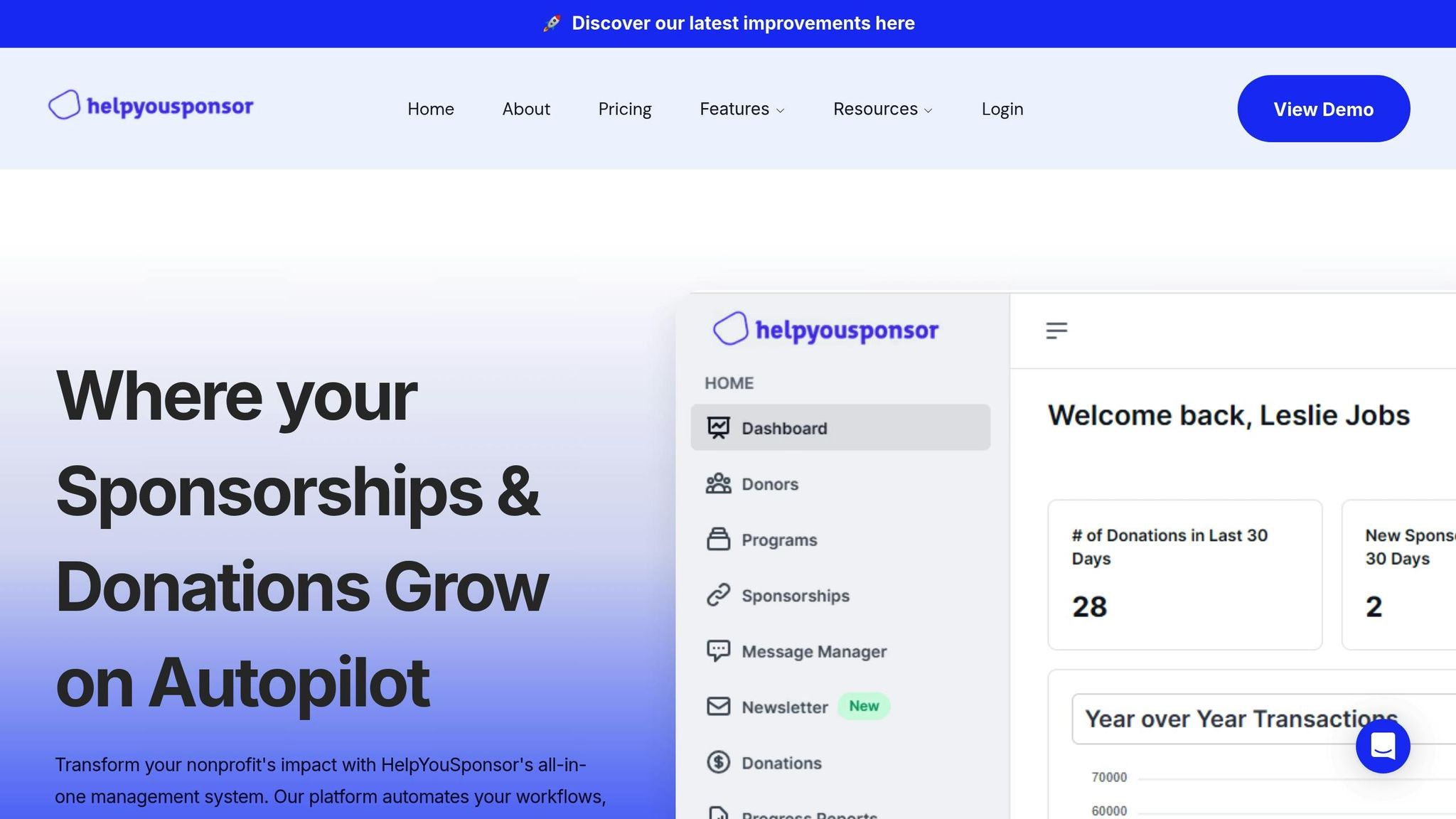Ultimate Guide to Donor Data Automation for Nonprofits
Explore how donor data automation enhances efficiency and engagement for nonprofits, streamlining processes and improving donor relationships.

Nonprofits face challenges managing donor tasks like tracking contributions, maintaining records, and keeping donors engaged. Automation is solving these issues by streamlining processes, improving accuracy, and boosting donor engagement. 79% of nonprofits now use automation tools, which can save time, reduce costs, and enhance relationships with supporters.
Here’s what donor data automation can do:
- Automates repetitive tasks: Handles data entry, donation processing, receipts, and personalized messages.
- Improves accuracy: Reduces errors in donor records and keeps data up-to-date.
- Boosts engagement: Personalized outreach increases repeat donations by over 80%.
- Saves time and money: Cuts manual task time by 20–30% and reduces operational costs by 15–20%.
- Provides insights: Advanced analytics help refine fundraising strategies and retain donors.
Platforms like HelpYouSponsor simplify donor management by automating 90% of sponsorship tasks, managing $19M+ in donations, and increasing sponsorships by 3.8×. By using tools like CRMs, automated workflows, and analytics, nonprofits can focus more on their mission while maintaining strong donor relationships.
Automation isn’t just about efficiency - it’s a way to stay competitive in today’s fundraising landscape.
Webinar: How to use automation to build meaningful donor connections
Core Components of Donor Data Automation
Creating an efficient donor data automation system hinges on three key components working in harmony. Each plays a vital role in capturing, organizing, and using donor information effectively.
Automated Data Collection Tools
The first step in donor data automation is using tools that gather information automatically. Online donation forms act as the main entry point, collecting essential details like donor contact information, donation amounts, and preferences.
Payment gateways such as Stripe, PayPal, and Square integrate with donation platforms to process transactions while capturing payment details, billing addresses, and transaction histories. This integration reduces manual data entry and minimizes errors.
Email capture systems add another layer by gathering subscriber details through newsletter sign-ups, event registrations, and volunteer applications. This helps nonprofits gain a broader understanding of supporter engagement beyond monetary donations.
No-code tools like Zapier, Airtable, and Make seamlessly connect these data sources. For instance, nonprofits can set up workflows where a new donation automatically updates the donor database, triggers a thank-you email, and places the donor into a specific communication segment. The Giving USA 2023 report highlights the importance of online engagement for nonprofits’ communication, fundraising, and advocacy efforts. These tools form the backbone of effective donor tracking and management.
Important Donor Data to Track
Once the right tools are in place, the focus shifts to identifying which data points provide the most valuable insights. Effective automation systems prioritize collecting the right data at the right time.
- Contact information and communication preferences: This includes email addresses, phone numbers, mailing addresses, and preferred ways to connect. Keeping this information up-to-date ensures effective outreach and aligns with donor preferences.
- Giving history and patterns: Tracking donation amounts, frequency, preferred methods, and seasonal trends helps nonprofits tailor their fundraising strategies. Understanding these patterns distinguishes one-time donors from recurring supporters.
- Employment details: Knowing where donors work can reveal opportunities for corporate matching gift programs, enabling nonprofits to maximize contributions.
- Demographic and engagement data: Information like birthdays, interests, volunteer history, and event participation allows for personalized communication. In fact, 67% of nonprofits use CRMs to manage donations and build meaningful supporter relationships.
Role of Donor Management Systems (CRMs)
Donor management systems, or CRMs, act as the central hub where all automated data collection comes together. These platforms organize donor information, track interactions, and analyze behavior.
Modern CRMs simplify workflows by automatically pulling data from donation pages, sending thank-you emails and receipts, and generating detailed reports for analysis. They also offer advanced features like donor segmentation and automated communication tailored to giving history, preferences, and engagement patterns.
CRMs integrate with marketing tools to send personalized messages and work with matching gift platforms to identify corporate giving opportunities. They also enhance event management by handling registrations, ticketing, and attendance tracking, while updating donor records and triggering follow-up communications based on participation.
The analytical capabilities of CRMs provide nonprofits with actionable insights. By tracking key fundraising metrics, organizations can identify trends, evaluate campaign performance, and refine their strategies. Research shows that improving donor retention by just 10% can boost the lifetime value of a donor base by 50% or more. This underscores the importance of leveraging data analytics for long-term success.
Setting Up Automated Donor Data Collection
Automating donor data collection can significantly improve efficiency, but it requires careful planning and execution. The success of such systems hinges on setting clear standards, connecting systems effectively, and assigning responsibility to maintain data quality over time.
Standardizing Data Entry
Consistency is the backbone of reliable donor data automation. Without it, even advanced systems can produce unreliable results, which can derail fundraising efforts.
Start by creating a data entry style guide that outlines how donor information should be entered, formatted, and categorized. This guide should address common inconsistencies, such as variations in names (e.g., "Robert" vs. "Bob") and formatting issues like "Street" versus "ST" in addresses.
"Data standardization is essential for nonprofits to effectively manage their donor data and make data-driven decisions." - Nonprofit Leadership Alliance
To further ensure accuracy, implement validation rules. Many modern systems can automatically check data as it's entered, flagging incomplete or incorrectly formatted information. Tools like dropdown menus and predefined values can also minimize manual errors by limiting input options to approved choices.
The process of standardization typically involves three steps:
- Assess your current systems: Review your data storage, policies, and staff capabilities to identify gaps.
- Develop a standardization plan: Set clear goals, timelines, and allocate resources effectively.
- Train your team: Provide comprehensive training on data governance, validation techniques, and ongoing maintenance practices.
Documenting your process with a Standard Operating Procedure (SOP) ensures consistency. This document should specify who handles data entry and detail the rules they must follow. Regular audits can help you spot errors and identify areas for improvement.
Once your data is standardized, the next step is integrating donation forms with payment systems.
Connecting Donation Forms and Payment Systems
After standardizing your data, the next priority is connecting donation forms and payment systems. This integration eliminates the need for manual data entry, reducing errors and streamlining the process.
Strategic placement of donation forms can enhance visibility and encourage donations. For example, embedding a prominent "Donate Now" button in your website's navigation bar makes it easy for visitors to contribute. Directing users straight to the donation form, without unnecessary steps, improves the donor experience and can boost conversion rates.
"As social interactions have gone digital, donations have moved into the digital realm as well, making it imperative that nonprofits evolve their ability to accept those digital donations." - Justin Wheeler, Funraise CEO and Co-founder
Offering multiple payment options, such as credit cards, Google Pay, and Apple Pay, can accommodate donor preferences while capturing comprehensive transaction data. Ensure your payment processor is PCI compliant, with features like encryption, secure passwords, and restricted access controls.
Keep donation forms simple and easy to navigate. Overly complicated forms can discourage donors, so focus on collecting only essential information. Since many donors use smartphones, mobile optimization is a must. You might also include an option for donors to cover transaction fees, which can increase the net amount received.
Automated features can further enhance the process. For instance, adding an option for recurring donations encourages continued support. Tools that check for corporate matching eligibility and capture employer details can also add value without complicating the form.
Assigning Data Ownership and Governance
Establishing clear accountability is critical for maintaining data quality. Without defined roles, even the best automation systems can falter due to inconsistencies and lack of oversight.
Assign specific team members to oversee different parts of your database, such as donor contact information, giving histories, and volunteer records. These individuals should regularly review and update their assigned data segments, ensuring accuracy and addressing any issues.
A strong governance framework is essential. This should include policies for data collection, storage, and security, as well as clear procedures for data entry, donor communication, and reporting. Define who has the authority to make changes to data standards, approve new methods, and resolve quality concerns.
"Organizations that use data standardization and data governance are more likely to achieve their fundraising goals." - Blackbaud
Routine data cleansing is vital for correcting errors and maintaining quality. Document these processes to ensure consistency and provide training to foster a culture of accountability. Quality monitoring systems can further enhance oversight by identifying issues early. Regular audits, tracking metrics like duplicate records and incomplete entries, and creating feedback loops for staff can help maintain database health.
Data privacy and security must also be a priority. Establish protocols for accessing, sharing, and retaining donor information to comply with regulations and maintain trust. Regularly review and update your governance framework to adapt to technological and organizational changes.
Improving and Maintaining Donor Data Automation
Getting your donor data automation system up and running is just the beginning. To truly benefit from it, you need to focus on ongoing maintenance and refinement. This ensures your system stays reliable and helps maintain the integrity of your donor data over time.
Maintaining Data Quality
Keeping donor data accurate and complete isn’t a one-time effort - it’s a continuous process. Interestingly, 54% of organizations cite incomplete or inaccurate data as a major hurdle in leveraging donor information effectively.
Start by using automated deduplication tools to merge duplicate records. These tools match entries based on details like email, phone numbers, or name and address combinations, reducing redundant data that could skew your analysis or lead to wasted communication efforts.
Next, implement automated error checks that flag and correct common mistakes as data is entered. Validation rules can catch issues like missing fields or incorrect formatting, ensuring your database remains clean from the start.
It’s also a good idea to establish a regular data quality schedule. This might include weekly reviews of flagged entries, monthly checks for duplicate records and outdated contact information, and quarterly audits of your entire database to address recurring issues. These scheduled tasks help keep your data in top shape.
Finally, train your team on data hygiene best practices. When everyone understands how accurate data contributes to fundraising success, they’ll be more invested in maintaining its quality.
Using Donor Segmentation and Personalization
Segmentation allows you to move beyond generic mass messaging and connect with donors on a more personal level. Start with basic categories like first-time donors, recurring donors, lapsed donors, and major gift prospects. Each group requires a tailored communication approach.
Why is this important? Because 72% of people engage only with personalized messages. Plus, with retention rates for new donors averaging just 20%, compared to about 60% for repeat donors, targeted messaging becomes a key strategy for long-term success.
Automated triggered messages are another powerful tool. For instance, you can set up a welcome series for new donors, send personalized thank-you notes based on donation amounts, or launch re-engagement campaigns for inactive donors. These automated touchpoints keep communication consistent without adding to your team’s workload.
For more advanced segmentation, consider factors like donation frequency, preferred communication channels, volunteer involvement, and location. Volunteers, for example, are 11 times more likely to donate, so they may warrant special messaging that acknowledges their unique contributions.
You can also personalize donation requests based on giving history. Aligning your ask with a donor’s past contributions ensures that it feels realistic and appropriate, which can improve response rates.
Keep an eye on key metrics like open rates, click-through rates, and conversion rates for each donor segment. This data helps you refine your approach over time, making your campaigns more effective.
Using Analytics and Reporting
Analytics take raw data and turn it into actionable insights - yet 76% of nonprofits don’t have a solid strategy for using analytics. This represents a missed opportunity to improve fundraising efforts.
Real-time reporting is a game-changer. Dashboards that track metrics like donation volume, average gift size, and conversion rates across channels give you instant visibility into what’s working. You can quickly identify successful campaigns and apply those strategies elsewhere.
Predictive analytics is another powerful tool. By analyzing behavioral patterns, you can identify donors who are likely to increase their giving, sign up for monthly contributions, or need re-engagement efforts. Machine learning tools can help you stay proactive, reducing the risk of donor lapses and identifying major gift prospects.
Campaign performance analysis is equally valuable. By evaluating factors like donor segments, communication channels, timing, and message content, you can uncover the combinations that deliver the best results. For example, you might find that major donors respond better to personal outreach, while younger supporters prefer engaging through social media.
Retention analysis is critical, especially since it costs 10 times more to attract new donors than to retain existing ones. Monitor retention rates based on factors like acquisition source, first gift size, and engagement level to identify your most loyal supporters and nurture those relationships.
To stay on top of changes, set up automated alerts for significant shifts in key metrics, such as declining retention rates or campaign performance. Equip your team with training to interpret these analytics and act on the insights, especially since 55% of organizations struggle with deciding which analyses to prioritize.
Finally, conduct regular performance reviews to compare your results against benchmarks. This helps you identify what’s working and where you can improve, creating a continuous cycle of optimization for your fundraising efforts.
Using HelpYouSponsor for Donor Data Automation

HelpYouSponsor provides a practical solution for nonprofits aiming to simplify donor data management. Designed specifically for organizations running sponsorship programs and maintaining donor relationships, this platform tackles the challenges nonprofits face when handling large-scale donor information. By combining automation with user-friendly tools, HelpYouSponsor helps streamline processes and reduce manual effort.
Since the platform is cloud-based, your team can access donor data and automation tools from anywhere. Building on the foundation of automated data collection, HelpYouSponsor enhances donor management with powerful integrations and efficient tools.
Simplifying Donor Data Collection
HelpYouSponsor automates the process of gathering donor information with customizable forms and integrated payment systems. These tools capture donor details automatically, whether the donation is a one-time contribution or part of a recurring commitment.
The platform’s centralized contact management system allows you to collect only the information that matters most. Whether you’re managing sponsorships, running campaigns, or organizing general fundraising efforts, you can adjust the system to capture exactly what you need.
One standout feature is its ability to integrate with major third-party systems. These integrations ensure donor data flows seamlessly between platforms, reducing the risks and errors that come with manual data entry.
Additionally, the platform’s data import/export tools make it easy to transition from older systems. You can bring in historical donor records or export data for analysis, reporting, or other uses without hassle.
Automating Donor Communications and Receipts
HelpYouSponsor simplifies donor communication by automating key tasks. The platform automatically generates donation receipts and sends personalized thank-you messages, ensuring donors are acknowledged promptly and professionally.
You can also create automated email campaigns triggered by donor actions. For example, you might set up welcome messages for new sponsors, send quarterly updates, or deliver renewal reminders - all of which operate in the background without manual intervention.
The platform includes an integrated messaging system that lets you send updates, letters, or photos directly to donors. Plus, a self-service donor portal allows supporters to update their information, review donation histories, and download tax receipts. For broader communication, the platform features a built-in newsletter tool and integrates with Mailchimp to keep your email marketing efforts organized and polished.
Integrated Reporting and Donation Tracking
HelpYouSponsor doesn’t just collect data - it turns it into actionable insights with real-time reporting and tracking. Every donation and sponsorship is recorded instantly, ensuring your reports are always up to date.
The platform provides detailed financial views by program, donor, region, or time period. Customizable dashboards highlight key metrics like new sponsorships and campaign progress, giving you a clear picture of your efforts.
Advanced search and filtering tools make it easy to find specific donor information or create targeted reports for different audiences. With QuickBooks integration, you can sync financial data seamlessly, cutting down on double-entry and reducing errors.
For those who need to demonstrate impact to donors or boards, HelpYouSponsor offers progress reports that can be automatically generated and customized for various stakeholders. Additionally, the ad hoc reporting feature allows you to create tailored reports for grant applications, board meetings, or donor updates, ensuring you always have the data you need at your fingertips.
Conclusion
Donor data automation has become essential for nonprofits navigating today’s competitive funding environment. With more organizations vying for limited resources, every donor relationship holds immense value. Automation not only boosts efficiency but also strengthens connections with supporters, making it a powerful tool for nonprofits to thrive.
The strategies and tools discussed earlier highlight how automation reshapes nonprofit operations. It’s not just about saving time - automation enhances fundraising visibility, clarifies donor expectations, and enables personalized communication. These improvements lead to higher donor retention and deeper relationships, often translating into increased contributions.
Modern tools take this further by using predictive analytics and automated workflows to engage donors at every stage of their journey. Platforms like HelpYouSponsor demonstrate how effective automation can drive real results, allowing nonprofits to amplify their impact without adding to administrative burdens.
To implement automation successfully, nonprofits should start with foundational steps: standardize data entry practices, integrate donation forms with payment systems, and assign clear data management roles. Maintaining high-quality data through regular audits, applying donor segmentation, and leveraging analytics to track performance are equally critical.
It’s important to note that automation doesn’t replace human relationships - it enhances them. By automating repetitive tasks, nonprofits free up time to focus on cultivating meaningful connections with their supporters, which ultimately furthers their mission.
With donor numbers dropping by 19% over the past decade and inflation-adjusted donations declining by over 10% in 2022, nonprofits can no longer afford to rely on outdated manual processes. Embracing automation is the key to engaging supporters, showcasing impact, and securing the funding needed to sustain their work. Now is the time to act.
FAQs
How can nonprofits maintain accurate and consistent donor data when using automation tools?
To keep donor information accurate and consistent, nonprofits need clear guidelines for entering data and a system for routinely checking their database for mistakes or duplicate entries. Using data validation tools during data entry and conducting regular audits can help identify and fix issues before they become bigger problems.
On top of that, having a regular data hygiene plan is key. This ensures donor records remain current and dependable, which is essential for meaningful engagement and smooth automation processes.
What are the main benefits of automating donor data with a nonprofit CRM?
Automating donor data using a nonprofit CRM comes with a range of benefits that can make a real difference in how organizations operate. For starters, it can boost donor retention by offering insights that help you nurture stronger, more meaningful relationships with your supporters. Plus, by automating time-consuming tasks like reporting and communications, your team can focus on what truly matters - making an impact.
Another advantage is the ability to centralize all donor information in one place. With everything from interactions and donations to engagement history easily accessible, it becomes much simpler to track and manage. This not only allows for more personalized donor experiences but also leads to better fundraising outcomes. On top of that, automation improves forecasting accuracy, enabling nonprofits to make smarter decisions and plan future campaigns with greater confidence.
How can donor data automation help nonprofits improve donor engagement and retention?
Donor data automation empowers nonprofits to strengthen their relationships with supporters through personalized communication. By leveraging automation, you can customize messages to align with each donor's preferences, past donations, and areas of interest, ensuring every interaction feels relevant and thoughtful.
Beyond personalization, automation streamlines time-consuming tasks like tracking contributions, updating donor records, and creating reports. This frees up your team to concentrate on fostering connections rather than getting bogged down in administrative work. Plus, automation delivers precise insights into donor behavior, allowing you to spot patterns and refine strategies to inspire lasting support.

